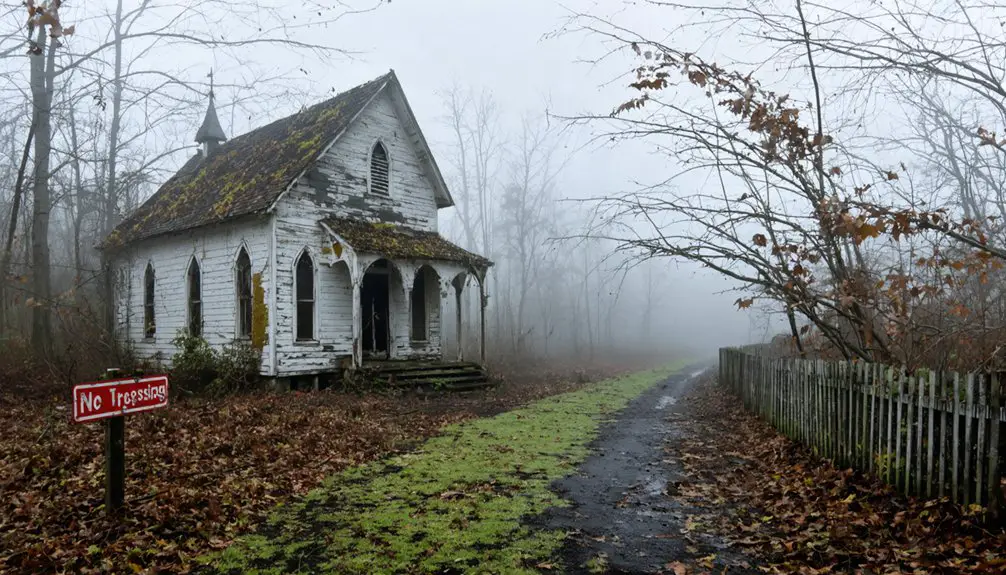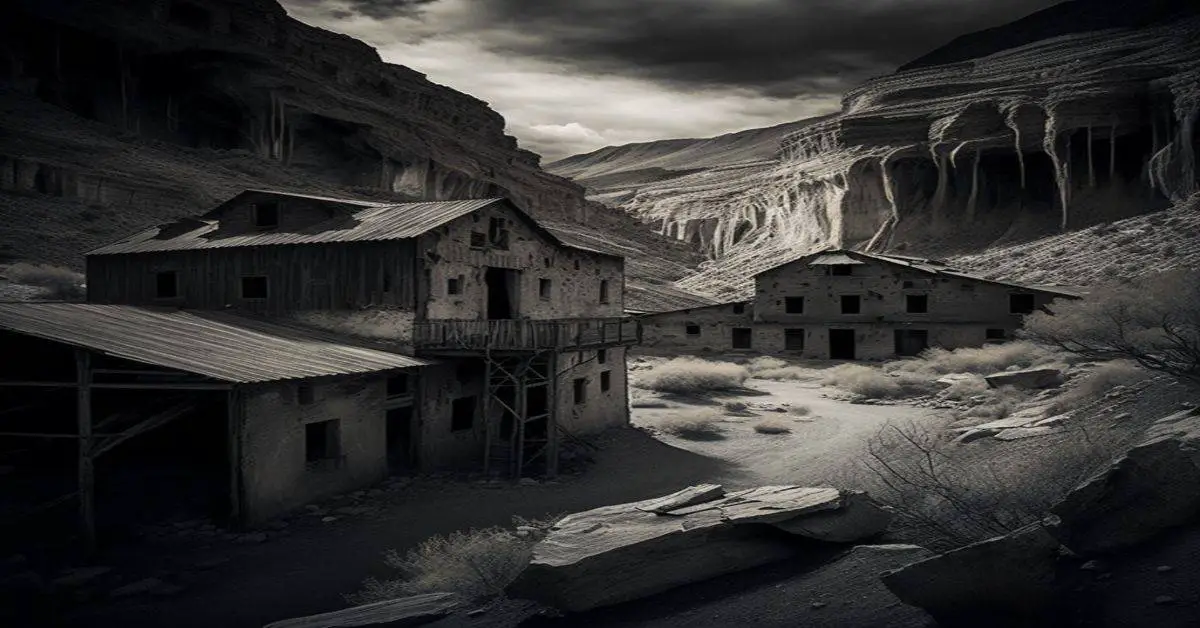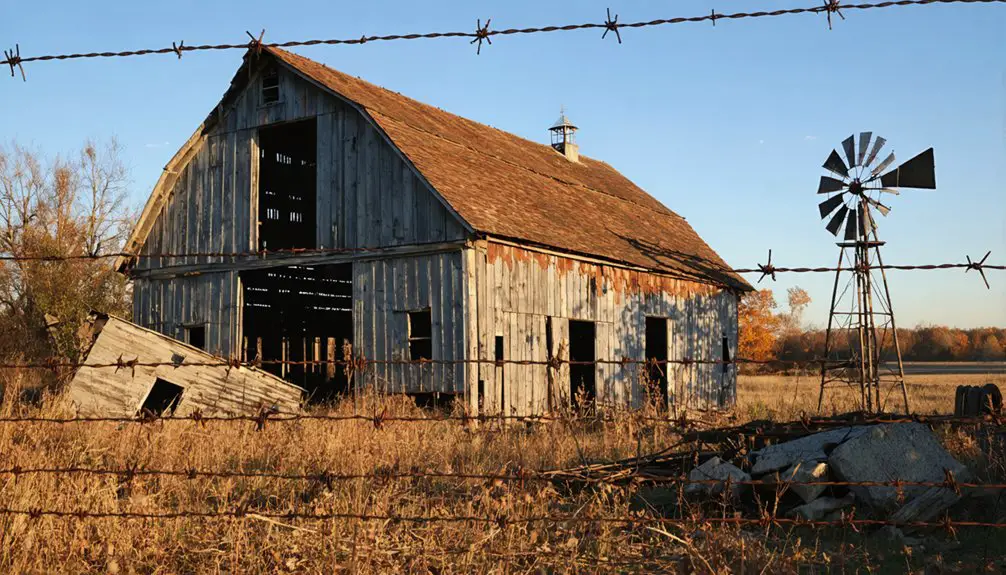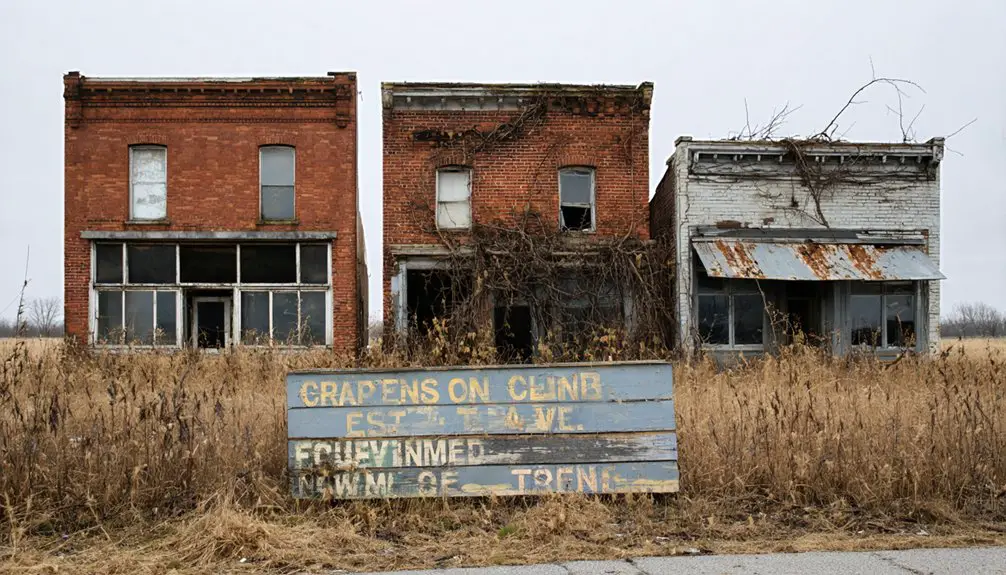You’ll find Boston Mills, Ohio – now known as “Helltown” – along the Cuyahoga River, where it emerged as Summit County’s first settlement in 1806. The town flourished through the 1800s with mills, railroads, and industry until 1974, when federal legislation granted the National Park Service eminent domain powers. This forced evacuation created a ghost town, sparking dark legends of supernatural activity. The abandoned buildings and folklore continue drawing curious visitors seeking to uncover Helltown‘s mysteries.
Key Takeaways
- Boston Mills transformed from a thriving mill town into “Helltown” after the National Park Service’s 1974 forced evacuation of residents.
- The abandoned buildings and sudden government takeover sparked supernatural legends and dark folklore throughout the area.
- Notable haunted locations include Crybaby Bridge and an abandoned Presbyterian church linked to alleged occult activities.
- The ghost town’s structures now stand within Cuyahoga Valley National Park, with some converted for historical preservation.
- Urban explorers frequently visit the remaining abandoned buildings, though many structures were demolished during the government acquisition.
The Birth of Boston Mills: Early Settlement Years
When Boston first emerged in 1806 as Summit County’s earliest settlement, it quickly established itself as an essential industrial hub along the Cuyahoga River. The early settlers recognized the river’s potential, constructing Summit County’s first mill that same year.
You’ll find that this strategic move sparked the birth of a thriving mill economy that would define the region.
As more pioneers arrived, Boston evolved into a network of interconnected villages collectively known as Boston Mills. Each small township depended on the milling operations, with residents combining industrial work and small-scale farming to make their living. The arrival of the railroad line through the area further supported the town’s growth and prosperity. The establishment of a paper factory brought significant employment opportunities to the growing community.
The community’s foundation rested firmly on the power of water-driven mills, setting the stage for what would become one of Ohio’s most significant early industrial settlements.
From Mill Town to Industrial Hub
You’ll find Boston Mills’ origins tied to water-powered grain and lumber operations along the Cuyahoga River in the early 1800s.
The Munroe brothers transformed the settlement in 1836 by establishing multiple mills and the Munroe Falls Manufacturing Company, which diversified into cotton, flour, paper, and other industries.
The arrival of the Valley Railway in 1880 accelerated the town’s industrial growth, connecting Boston Mills to Cleveland and Zoarville while enabling efficient transport of raw materials and finished products. The town reached its peak with a population of 300 residents by 1842. The Cleveland-Akron Bag Company later became a major employer, with nearly 200 workers contributing to the town’s economic vitality.
Early Water-Powered Mills
As the Cuyahoga River carved its path through northeastern Ohio, Boston Mills emerged as a thriving industrial center following the construction of its first dam and mill in 1821.
You’d find this pioneering mill on the west bank, where innovative waterwheel mechanics transformed river power into rotational energy.
The complex gear systems could boost speeds dramatically – when the waterwheel turned once, the millstones spun 100 times.
Like many early Ohio mills, Boston Mills utilized steam-powered machinery by the 1830s, increasing its production capacity significantly.
With the opening of the Ohio and Erie Canal in 1827, the mill town experienced rapid growth and development.
Railroad Accelerates Town Growth
The arrival of the Valley Railway in 1880 transformed Boston Mills from a struggling canal town into a bustling industrial hub. You’ll find this railway economy sparked dramatic growth, reversing the decline that followed the canal’s closure in 1861.
The railroad’s strategic design, with its downhill grade and wide curves, allowed heavier freight loads to reach Cleveland efficiently.
The transportation transformation reshaped the town’s identity. You can trace how the Cleveland-Akron Bag Company and other manufacturers built facilities along the tracks around 1900, complete with worker housing and company stores.
The railway moved everything from coal and iron to livestock and farm products, connecting Boston Mills to broader markets. New jobs in railroad operations and freight-dependent industries shifted the community from agricultural roots to industrial prosperity. The Valley Railway established a crucial flag stop station that helped facilitate the town’s industrial expansion.
Life Along the Cuyahoga River
As you explore Boston Mills’ early days, you’ll notice how the Cuyahoga River‘s rushing waters powered the town’s industrial growth through gristmills and sawmills.
The river’s strategic location near the Ohio & Erie Canal system helped local mill operators expand their trade networks and boost production capacity. The U-shaped river flows over 100 miles through Ohio before reaching Lake Erie.
The winding path of the river, carved by glacial retreat thousands of years ago, created an ideal setting for early industrial development.
River-Powered Industrial Growth
Powering the industrial revolution in Northeast Ohio, Cuyahoga River’s dramatic elevation changes provided essential mechanical energy to early manufacturers before the widespread adoption of electricity.
This industrial innovation transformed sleepy riverside towns into manufacturing powerhouses, particularly at locations like Akron where the water divide created ideal conditions for powering mills.
The river’s natural force attracted diverse industries that would shape America’s future:
- Standard Oil established refineries along the banks, leveraging water power and transport
- Rubber giants like Goodrich built massive manufacturing operations near the falls
- Steel mills and oat processors clustered around strategic river bends
While this growth brought unprecedented prosperity, its ecological consequences would later manifest in infamous river fires and severe contamination, ultimately sparking national environmental reforms. Since Moses Cleaveland’s arrival in 1796, the river has been a vital industrial resource that shaped the region’s economic development.
Mill Operations and Trade
Located along the Cuyahoga River’s bustling trade route, Boston Mills transformed from a subsistence farming settlement into a thriving commercial hub during the early 19th century.
You’d find local farmers shifting from pig and corn production to profitable wheat and cattle operations, all powered by the water-driven mill established by 1842.
The town’s strategic position along the Ohio and Erie Canal opened crucial trade routes north to Cleveland and south to Akron.
You could spot canal boats laden with wheat, coal, flour, beef, and cheese heading to U.S. and European markets, while British goods like ceramics flowed back into town.
The Federal Land Acquisition Project
During the early 2000s, the Federal Land Acquisition Project launched an ambitious initiative to secure critical parcels within and surrounding Boston Mills as part of the Cuyahoga Valley National Park‘s expansion efforts.
Through strategic land preservation and funding strategies, the project protected key areas from residential development while enhancing visitor services and environmental restoration.
You’ll find these major accomplishments from the project:
- Acquisition of 568 acres near Blossom Music Center by 2011
- Development of the Boston Mill Visitor Center through $7 million in combined federal and private funding
- Protection of 3.3 miles of Cuyahoga River ecosystem from Boston Mills Road to Vaughn Road
The Trust for Public Land and the Conservancy for Cuyahoga Valley National Park partnered with federal agencies to facilitate these essential land transfers, ensuring long-term preservation of the area’s natural and historical resources.
Overnight Ghost Town: The Mass Exodus
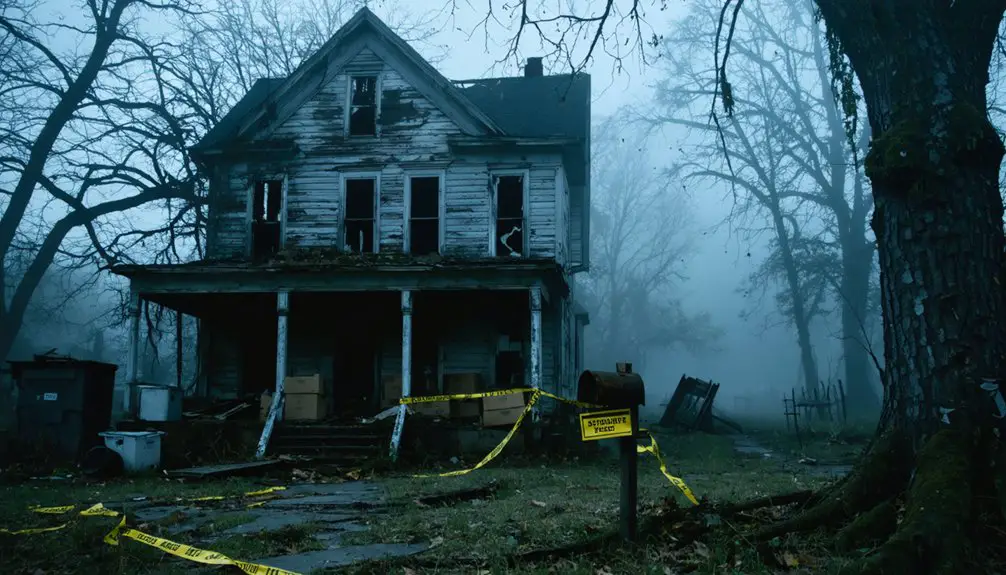
When federal legislation granted the National Park Service sweeping eminent domain powers in 1974, Boston Mills’ fate was sealed.
You would’ve witnessed a heartbreaking display of historical injustice as hundreds of residents were forced to abandon their homes almost overnight, with little to no warning. The government’s mass evacuation order shattered generations of community resilience, giving families no chance to negotiate or properly plan their relocation.
The exodus left behind a haunting tableau of vacant homes marked with government “No Trespassing” signs and poignant graffiti reading “Now we realize how the Indians felt.”
The town’s sudden abandonment created deep wounds, as families who’d lived there for generations saw their tight-knit community torn apart, their properties seized at low prices, and their hometown transformed into a ghost town.
Birth of the “Helltown” Legend
Shortly after the mass exodus, Boston Mills transformed into something far more ominous than a simple ghost town.
The sudden government intervention, marked by mass property acquisitions and demolitions, sparked dark rumors about the town’s fate. You’d find “Government Property” signs everywhere, blocking access to entire streets while abandoned buildings decayed behind them.
Barricaded streets and crumbling homes stood as silent witnesses to the government’s mysterious takeover of Boston Mills.
From these unsettling circumstances, the Helltown folklore emerged:
- Local residents spread tales of unexplained disappearances and government cover-ups
- The overgrown, isolated landscape became synonymous with paranormal activity
- Stories of ghosts, cults, and serial killers intertwined with the town’s documented history
The rapid transformation from thriving mill town to forbidden zone captured the public’s imagination, and urban explorers began documenting their eerie encounters, cementing Boston Mills’ reputation as “Helltown.”
Haunting Tales and Local Mythology
If you venture onto Boston Mills’ infamous Crybaby Bridge at night, you’ll encounter the haunting cries of ghostly children and witness mysterious orbs of light floating above the water.
The abandoned Presbyterian church, with its Gothic revival architecture featuring inverted crosses, became the rumored site of occult rituals and animal sacrifices that supposedly awakened dark forces.
Local legends tell of mutant creatures lurking in the dense forest surrounding these locations, with witnesses reporting encounters with deformed humanoids and unexplained animal-like creatures prowling the area after dark.
Supernatural Bridge Encounters
Among the most enigmatic features of Boston Mills’ supernatural landscape stands a modern bridge on Boston Mills Road, which has garnered a reputation for mysterious occurrences since its construction in 1999.
You’ll find reports of ghostly handprints mysteriously appearing on vehicles parked near the bridge, though paranormal investigations using infrared cameras and electromagnetic detectors haven’t produced conclusive evidence of supernatural activity.
While exploring Boston Mills’ haunted bridge, keep in mind:
- The bridge replaced an old covered structure that likely contributed to earlier ghostly perceptions.
- Despite its “Crybaby Bridge” nickname, no credible reports of infant cries exist.
- The site’s reputation stems from its connection to broader Helltown legends and local folklore.
Ritual Sites and Legends
Deep within Boston Mills’ abandoned landscape, a web of supernatural legends and ritual sites has emerged over generations, centered primarily around its vacant churches and historic grounds.
You’ll find upside-down crosses adorning abandoned Presbyterian churches where ritual practices allegedly occur, with unexplained candles burning in empty windows. A mysterious hermit is said to guard the Boston Community Church’s basement.
The land’s dark history stems from an early Native American massacre, leading to persistent ghost sightings and claims of restless spirits.
Local legends tell of frontier-era serial killings and tragic deaths, particularly near the cemetery. These stories intertwine with reports of occult gatherings and animal sacrifices, while nearby “End of the World” signs and a toxic dumpsite add an apocalyptic element to the town’s sinister reputation.
Mutant Creature Stories
The dark mythology of Boston Mills extends beyond spiritual hauntings to include tales of mutant creatures, most importantly stemming from the infamous Krejci Dump site. Local legends tell of the “Peninsula Python,” a massive mutated snake that allegedly terrorizes trespassers, though no verified creature sightings exist.
Despite the presence of toxic waste at Krejci, there’s no evidence of mutations affecting wildlife or residents.
- You’ll find these mutant legends intertwined with government conspiracy theories about chemical spills and cover-ups.
- The abandoned atmosphere of Boston Mills fuels stories of mutant encounters on cursed roads and in empty buildings.
- While environmental studies debunk these claims, the mutant mythology remains central to Helltown’s mysterious identity.
Environmental Conservation vs. Community Preservation
During the 1970s, a stark conflict emerged between environmental preservation and community rights as the U.S. government acquired Boston Mills properties to establish Cuyahoga Valley National Park. The federal purchase of land at below-market prices forced residents from their homes, fracturing long-established community bonds and erasing local traditions.
While conservation efforts successfully protected the region’s biodiversity and natural landscapes, the community impacts were severe. Historic buildings were demolished or abandoned, including the Presbyterian church, effectively erasing Boston Mills’ cultural heritage.
Conservation conflicts arose as residents, armed with limited legal options against eminent domain laws, watched their town transform into protected parkland. Though the rewilded landscape now supports diverse wildlife and provides recreational opportunities, the displacement of Boston Mills’ residents remains a contentious example of environmental priorities overriding community preservation.
Urban Exploration and Modern Tourism
Since Boston Mills‘ transformation into parkland, modern urban explorers have flocked to this infamous ghost town, now widely known as “Helltown.”
Fire-damaged structures, graffiti-covered walls, and overgrown paths create an eerie atmosphere that draws visitors fascinated by decay and abandonment.
Your thrill seeking adventures here come with risks, as many buildings remain structurally unsound.
The mix of urban decay and local folklore has transformed this former village into a dark tourism destination, though access remains complicated by unclear boundaries within the National Park.
- Watch for hazards like unexploded debris and unstable structures
- Respect preservation efforts by avoiding vandalism and staying on marked paths
- Be aware that some areas require permits or are off-limits due to safety concerns
Legacy Within Cuyahoga Valley National Park
Beyond its reputation for urban exploration, Boston Mills stands as an essential cornerstone within Cuyahoga Valley National Park‘s rich heritage.
You’ll find a remarkable blend of cultural heritage spanning from the early 19th-century canal era through the industrial age. After the Ohio and Erie Canal’s 1827 opening, the village flourished with mills, warehouses, and a bustling population of 300 by 1842.
Boston Mills captures America’s canal-era spirit, transforming from wilderness into a thriving industrial village along the Ohio and Erie Canal.
While canal traffic declined, the arrival of rail transport in 1880 sparked renewed growth.
Today, the Boston Mill Visitor Center, housed in the restored Cleveland-Akron Bag Company building, showcases this legacy of historical preservation. The center, opened in 2019 through $7 million in community funding, serves as your gateway to discovering the park’s natural wonders and industrial past.
Frequently Asked Questions
Are There Any Remaining Original Residents Still Living Near Boston Mills Today?
Like scattered seeds finding new soil, you’ll find descendants of original residents preserving local history in surrounding Summit County communities, but current residents can’t legally live within Boston Mills’ abandoned boundaries.
What Happened to the Businesses and Jobs That Existed Before Abandonment?
You’ll find that rapid government seizures caused total business decline, wiping out mills, stores, manufacturing, and transportation jobs. The economic impact devastated workers who lost their livelihoods without local alternatives.
How Much Compensation Did Residents Receive for Their Seized Properties?
You won’t find specific compensation figures in historical records, but residents reported their property valuations were unfairly low and non-negotiable when the government seized their land through eminent domain.
Did Any Families Successfully Resist the Government’s Land Acquisition Efforts?
You won’t find any documented cases of successful family resistance to the land acquisition – historical records show no families managed to retain their properties against the government’s extensive eminent domain takeover.
What Specific Environmental Threats Prompted the Creation of the National Park?
You’ll find two major threats drove conservation efforts: widespread deforestation threatening natural landscapes, and toxic chemical contamination from the Krejci Dump that caused environmental degradation and health risks to wildlife and humans.
References
- https://www.youtube.com/watch?v=MqeHr-inQ08
- https://travelswithabandon.com/2019/05/13/adventure-12-boston-mills-oh/
- https://www.atlasobscura.com/places/helltown-ohio
- https://colonialghosts.com/tale-of-helltown-ohio/
- https://www.americanhauntingsink.com/helltown
- https://thelittlehouseofhorrors.com/helltown/
- http://www.gribblenation.org/2024/11/boston-mills-road-cuyahoga-valley.html
- https://npshistory.com/series/archeology/mwac/tech/54.pdf
- https://www.conservancyforcvnp.org/a-visual-history-of-boston-mill/
- https://npshistory.com/publications/cuva/nr-boston-mills-hd.pdf
